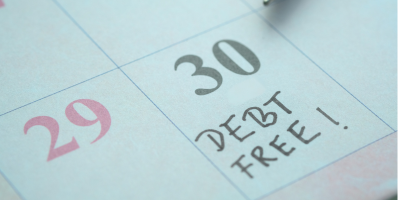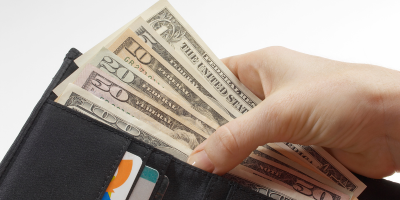Financial success doesn’t come easy, which is why we need to pay attention to the details that come with budgeting. This series, How to Implement a Budget and Achieve Your Goals, gives you a clear “how-to” when it comes to your plan.
If you missed the earlier installments, I highly recommend you check them out. (You can find the first one HERE.)
Addressing Debt and Savings
You’ve verified your income, added up all of your expenses, and even come up with some variable expense funds you’d like to implement. Sure, you don’t have any idea how to put it all together yet, but that’s okay because we still have a little more information to cover before we get down to making that budget work in entirety.
Debt
One of the most common goals that people have financially is to be debt free. In fact, if you look up average credit card debt in the United States alone, many sources have the amount near or above $5,000 per household. That’s just credit card debt! Student loans, car payments, medical bills, and mortgages can increase that amount to over $120,000 per household. When asked, a lot of people don’t even know how much money they owe, and simply pay the monthly payment each month until the cards are maxed out.
I know it’s not a topic people like to talk about, but if you intend to put together a budget that will succeed, one of the most important things to do is to determine how much debt you have. And that means being honest. Have a credit card your spouse doesn’t know about? Have student loans that have gone into default? It’s time to come clean and get it all down on paper.
Your Turn to Implement a Budget:
To do so, I’ve created a handy (and FREE) Debt Tracker Worksheet for you. Start by writing each and every debt you have down on that worksheet. Research your total amount owed (as of today’s date) and the interest rate that coincides with that debt. You’ll also want to write down what the minimum payment is as well.
Ask your spouse to look it over and make sure that there isn’t any money owed missing from that list. If you plan to be successful in meeting those goals (remember the ones you made together?), you won’t want to miss a thing.
Feeling overwhelmed by the amount of debt listed? Don’t worry, we will address exactly how to make a plan and stick with it coming up in a later installment of this series.
Savings
When you think about saving, I bet your mind immediately goes back to that piggy bank that sat atop your dresser for all of your growing up years. Perhaps all of the money you received from your Grandma ended up stuffed in there, along with every type of loose change imaginable. If you weren’t allowed to touch it, then it might have become a source of frustration for you as a child that just wanted to purchase a new Barbie doll or toy car.
Saving as an adult is a bit different, and it’s one of the things that many people don’t even consider until their finances are in such a bad place that there doesn’t seem to be any good reason to do so. Trust me, I’ve been there, living from paycheck to paycheck and not seeing how saving money would happen, much less be useful long-term.
My opinion on that matter has changed over the years, though, and having clearly defined savings has made all of the difference in my family’s finances.
Emergency Fund
If you’ve ever read any blog post, Pinterest pin, or book on creating a budget, planning for the future, or saving, then you may feel that the topic of emergency funds gets more attention than it deserves. Perhaps you’ve struggled for a long period of time to put together an emergency fund, only to have multiple emergency situations immediately wipe it out. On the other hand, maybe you don’t even truly understand what an emergency fund is, or why you should even have one. Trust me, I’ve been there.
For years, the idea of having an emergency fund baffled me. I knew it was step one on all the lists of things to do when starting a budget, but I couldn’t figure out the point of having money stuck away in a savings account somewhere, rather than simply using that money to pay off debt. I’d learned to depend on my credit cards as a form of “emergency fund” and didn’t understand the difference between having money in an account versus a credit limit of the same size. I know now, they are two completely different things.
If you haven’t read my post: Do You Need An Emergency Fund?, head over and check it out before continuing.
Don’t worry, we’ll wait.
How much should I save?
A great starting place for an emergency fund is around $1,000. It might not seem like a lot, but it will help significantly if something unexpected comes up. Ultimately, the amount that you choose to reserve in an emergency fund will be specific to your own family’s situation. Some people like to pick the amount of their highest deductible (for us that would be $2,500), and others want to have three to six months’ worth of total income in the bank in case of job loss.
In fact, I put out a poll on Twitter recently and came up with a variety of responses.
I think this number is going to be unique to the individual. I want enough in my emergency fund to be able to cover 4 months of living expenses without any income. For me, I figure that’s about how long it would take me to find employment in my field.
— Reducing the Overload (@ReduceOverload)
Minimum is $500 cash on hand.
Not counting savings in the bank.
What if banks are not available. You have some cash.— Belinda Perez McDanel (@BelindaMcdanel)
I’m thinking $3,000 in cash inside a safe within your home. Another couple thousand in a bank where you can transfer to your main checking account in one phone call.
Why? In case your furnace goes out or car doesn’t work. So $5,000 total should cover a majority of things.
— Mark Shrigley (@mark_shrigley)
Ultimately it comes down to remembering the goals you made and deciding what’s important to you in the short- and long-term.
Create a Plan
As I mentioned previously, it’s important to have a plan in place for your emergency fund. This might seem pretty self-explanatory, but I promise you, for most people it is not.
For example, it’s easy to say that if the house floods, the deductible will come out of that emergency fund you’ve so carefully stashed away. Obviously, water in the house resonates with “emergency” status for all involved, correct?
What if, on the other hand, the television breaks right before Super Bowl Sunday. Your husband is a huge fan and you’ve already purchased the perfect snacks to serve during halftime. You don’t have money stashed away in other funds and, even if the entire family promises not to eat for the rest of the month, it still won’t cover the cost of a new television. What do you do?
Do you constitute this as an emergency and dig into the emergency fund?
Make the decision ahead of time and when the question comes up, you will already have the answer, even if you have to move the entire party to a place that actually has a working television.
Other Funds
Of course, savings doesn’t have to be limited to only emergency funds. In fact, in my own budget, I have a vacation fund, game night fund, and a household fund as well. Each month I put a predetermined amount of money into each of those funds and it carries over until that money is needed or we have saved enough to accomplish a task on our list.
By having these funds, we are less likely to dig into the emergency fund for small household expenses, a vacation we really want to take, or even so that we can host a board game night at our home. Instead, we’ve planned ahead, and the money is set aside for those specific expenses that matter a lot to our family happiness.
These funds will be specific to your own family, and I highly recommend you put at least a minimum amount in your emergency fund before you start funding other activities in your life. Of course, we will talk about this more when we talk about how to put the budget together in such a way to meet our goals.
Your Turn:
Using the FREE printable Emergency Fund Worksheet, determine the following:
- What is the amount of money you feel comfortable having in your emergency fund?
- How much do you currently have to put toward that fund? (Think of money in savings already, or cash on hand that could be diverted.)
- Ask yourself what will constitute as an emergency. Write down specific instances where dipping into that fund will be appropriate, and detail others that will definitely not be okay. Trust me, you’ll be happy you did.
If you intend to incorporate “other funds” into your budget, I highly recommend using the FREE printable Other Funds Worksheet and answering the following questions:
- Which other funds will you include?
- Why is each fund important?
- How much will each individual fund need to have in it? Will you add a certain amount each month until the fund reaches an upper limit, or will that money continue to accrue?
Keep in mind that once we get that budget put together, your ideas for how soon and how much might change slightly, but that’s okay. It’s good to have all of the pieces before you put the puzzle together, correct?
And that’s just what we are going to do in the final installment of this Implement a Budget Series.



